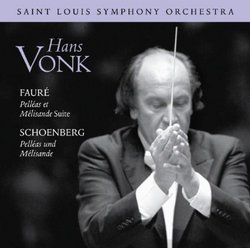| All Artists: Gabriel Faure, Arnold Schoenberg, Hans Vonk, Saint Louis Symphony Orchestra Title: Fauré: Pelléas et Mélisande Suite; Schoenberg: Pelléas und Mélisande Members Wishing: 0 Total Copies: 0 Label: Pentatone Release Date: 9/30/2008 Genre: Classical Styles: Forms & Genres, Theatrical, Incidental & Program Music, Symphonies Number of Discs: 1 SwapaCD Credits: 1 UPC: 827949032462 |
Search - Gabriel Faure, Arnold Schoenberg, Hans Vonk :: Fauré: Pelléas et Mélisande Suite; Schoenberg: Pelléas und Mélisande
 | Gabriel Faure, Arnold Schoenberg, Hans Vonk Fauré: Pelléas et Mélisande Suite; Schoenberg: Pelléas und Mélisande Genre: Classical |
Larger Image |
CD Details |
CD ReviewsTwo Works Based on 'Pélléas et Mélisande', Neither by Debuss J Scott Morrison | Middlebury VT, USA | 10/16/2008 (5 out of 5 stars) "Maurice Maeterlinck's symbolist play 'Pélléas et Mélisande' swept across Europe with a force belied by its static plot and dreamy atmosphere. It inspired an opera by Debussy and orchestral works by Sibelius, Schoenberg, Fauré, and Marius Constant, among others. The most famous of these, of course, is Debussy's opera. Schoenberg's and Fauré's works hold a place in the orchestral repertoire and are represented here by excellent performances by the Saint Louis Symphony Orchestra under its erstwhile music director, Hans Vonk (1942-2004), recorded in live performance in Saint Louis's Powell Hall in 1998 (Schoenberg) and 1999 (Fauré). The two works could not be more different. The Fauré, brief, delicate and impressionist, consists of four movements lasting about fifteen minutes. The Schoenberg, outStraussing Richard Strauss, requires a huge orchestra and lasts almost forty minutes. The Fauré was initially written to accompany a London production of Maeterlinck's play. Fauré later expanded some movements and eliminated others and, not including the Prélude and an ethereal Sicilienne, they illustrate Mélisande at her spinning wheel, and her death at the end of the play. The Saint Louis, under Vonk's sensitive direction, play the suite with utmost musicality.
Schoenberg's work is in one movement and it limns a number of the scenes of the play while, according to Alban Berg, hewing to the form of a one-movement symphony with four discernible sections. The work was originally intended to be an opera; the subject had been suggested by Schoenberg's mentor, Richard Strauss. But Schoenberg abandoned the project -- possibly because Debussy's opera had premiered the year before -- and turned it into its present orchestral form. It teems with leitmotivs, dense polyphony, gnarled harmonies, and rather overwrought emotions, the latter rather a far cry from the delicate reserve one experiences with Debussy's treatment (and indeed with Maeterlinck's play itself). The excellent booklet notes by Paul Schiavo outline the work's musical correspondences to incidents in the play. Musical highlights include the section where Mélisande and Pélléas meet, their love, and finally her death. This work is one of Schoenberg's later essays in late Romantic style and one hears harmonies straining to break free of tonality. The Saint Louis play the work with all the involvement and verve one could expect. It is a pleasant surprise to come upon the pages in the booklet in which every SLSO musician involved in the recording is named. One could only wish that this bow to the marvelous musicians who bring us such wonderful recordings were the case for more recordings. Perhaps the listing was done here because this CD is on the SLSO's own label. Whatever the reason, it is appreciated. Scott Morrison" |
